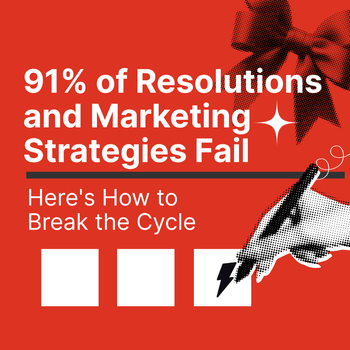The Importance of a Strong Creative Strategy in 2025
by Chad de Lisle • July 25, 2025
Let’s face it, marketing teams in 2025 are fighting for relevance, oftentimes against one another. The platforms are noisier. The algorithms are smarter, and buyers are more skeptical, selective, and empowered than ever.
A strong creative strategy isn’t optional anymore.
It’s the difference between being seen and being scrolled past. And it’s not just about producing more content—it’s about creating the right content, with intention, across the entire customer journey.
At Disruptive Advertising, we believe great creative starts with vision, connects through strategy, and wins through execution.
Let’s break that down.
Vision: Why Creative Will Be the Key Differentiator in 2025
Let’s be honest: most brands look and sound the same.
That’s why creative has become the great separator. It’s how you stand out when every feed, inbox, and SERP is packed with competitors saying, “look at me.” The brands that win in 2025 will be the ones that use creative not as decoration, but as a strategic asset.
Why creative matters more than ever:
- Customer expectations are rising: Audiences expect personalized, relevant content from brands that “get them.”
- Channels are saturated: The volume of content is at an all-time high. Creativity is the only way to break through.
- Brand loyalty is fragile: Great creative builds emotional connections and keeps you top of mind, even when competitors lower their prices.
- AI has leveled the playing field: When everyone can generate content, creativity is what makes yours matter.
Even the smartest strategy fails without excellent creative execution. We see it every day. If your ads or content don’t grab attention and create clarity, they’ll never get the chance to convert.
Strategy: Building a Creative Strategy That Aligns With Your Goals
Creative work should never be random.
The strongest creative strategies are built on a foundation of business goals, audience insights, and market context.
Here’s a solid, practical framework that can help build a strong creative strategy:
1. Start With Business Objectives
Every piece of creative should ladder up to a clear goal. Whether it’s driving qualified leads, improving brand recall, or increasing average order value, start with measurable outcomes.
Ask yourself:
- What exactly are we trying to move?
- How does creative influence that metric?
2. Know Your Audience Like It’s Your Job (Because It Is)
Your audience is not everyone. Build your creative around the people most likely to care, click, and convert.
Use audience data to uncover:
- Pain points and motivators
- Language and tone preferences
- Formats and platforms they engage with the most
If your personas feel vague, it’s time for a refresh. You can’t create powerful messaging if you don’t know who you’re talking to.
3. Define the Brand Voice & Visual Identity
Your brand should be recognizable, even without a logo.
- Is your tone consistent across platforms?
- Are your visuals aligned with how you want to be perceived?
- Does your content “sound” like it came from the same brand?
This is especially critical as you scale your content and work across teams or agencies.
4. Map Creative to the Customer Journey
What works for awareness doesn’t work for conversion. A strong creative strategy accounts for the full funnel.
| Funnel Stage | Creative Focus |
| Awareness | Eye-catching, emotionally resonant content |
| Consideration | Value-driven, informative, trust-building |
| Conversion | Clear CTA, urgency, product-specific messaging |
| Loyalty | Community-based, post-purchase support, education |
Pro tip: Repurpose your strongest ideas across multiple formats. One video can become an ad for your paid social campaigns, blog embed, email CTA for your lifecycle marketing, and even a retargeting asset.
Execution: How to Bring Your Creative Strategy to Life
This is where most brands fall short. They have a great idea or a slick pitch deck, but they never bring it to market effectively.
That’s why execution is everything.
Here’s how we recommend putting your creative strategy into motion:
1. Assemble the Right Team
Creative doesn’t happen in a vacuum. You need strategists, designers, copywriters, media buyers, and analysts all working from the same playbook.
- Define clear roles
- Align everyone to the same KPIs
- Use a shared creative brief format for consistency
2. Build a Feedback Loop
Real creative performance comes from iteration, not perfection. Launch quickly, test everything, and learn fast.
- Use A/B testing to compare messaging, visuals, and formats.
- Set up tracking to measure creative-specific performance.
- Don’t just test ads—test PPC landing pages, emails, and even confirmation pages.
3. Standardize Creative Operations
A scalable creative process helps you keep up without burning out.
- Use tools like Asana, Notion, or Monday to manage creative projects.
- Develop templated briefing and review processes.
- Use version control and asset libraries for efficiency.
4. Audit and Optimize Regularly
Don’t “set and forget.” Your creative should evolve based on performance, audience feedback, and market changes.
Set a quarterly cadence to:
- Review creative performance by campaign and channel
- Retire underperforming assets
- Refresh top-performers with updated design or messaging
Future-Proofing Your Creative Strategy
If you want to lead—not just survive—in 2025, your creative strategy needs to be:
- Data-informed
- Customer-first
- Consistently executed
- Aligned with real business outcomes
And most importantly, it should never be treated as a side project. Creative is the strategy.
At Disruptive Advertising, we don’t just make things look pretty. We develop creative strategies that drive results—grounded in insights, executed with excellence, and optimized for growth.
Want to see what a real creative strategy looks like for your business?





